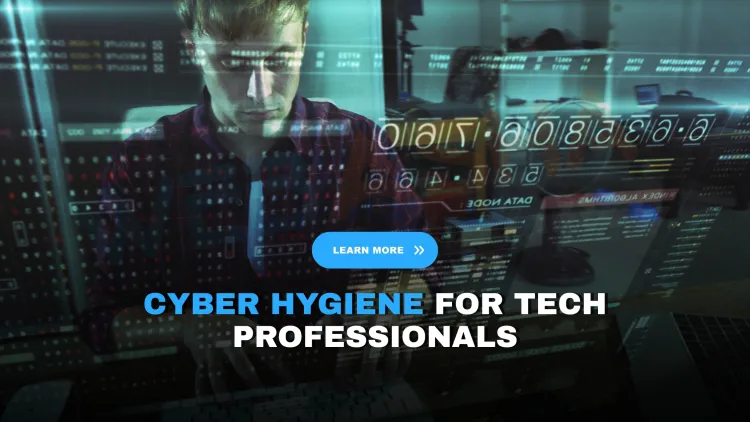Why Every Tech Professional Needs to Learn Basic Cyber Hygiene in 2025 | Secure Your Career in a Threat-Filled Digital World
In 2025, cyber hygiene is no longer optional—it's essential. As cyber threats grow more complex, every tech professional must understand and apply basic cybersecurity practices. Whether you're a developer, system admin, or data analyst, poor cyber hygiene can expose sensitive data, disrupt operations, and damage reputation. Practicing strong cyber hygiene habits like password management, software updates, phishing awareness, and device security ensures a safer digital environment for both individuals and organizations.

In the evolving landscape of cybersecurity, Cross Site Scripting (XSS) remains one of the most common and dangerous vulnerabilities found in web applications. Despite being well-documented and well-known, XSS continues to pose serious risks for websites, organizations, and users across the globe.
In this blog, we’ll break down:
-
What XSS is
-
How it works
-
Real-world consequences
-
Types of XSS
-
How to protect against it
✅ What is Cross Site Scripting (XSS)?
Cross Site Scripting (XSS) is a web security vulnerability that allows attackers to inject malicious scripts into webpages viewed by other users. These scripts run in the context of the victim's browser, enabling attackers to steal data, hijack sessions, or perform actions on behalf of the user without their consent.
In simple terms: XSS tricks a user’s browser into trusting and running malicious code on a legitimate website.
How XSS Works: Step-by-Step Breakdown
The process typically involves four key steps:
-
Attacker sends a malicious link containing an embedded script to a user (via email, message, etc.)
-
Victim clicks the link and unknowingly lands on a legitimate site.
-
The legitimate site loads in the victim’s browser, but the attacker’s script executes alongside.
-
Malicious script runs, sending sensitive data like session cookies back to the attacker.
Why XSS is Dangerous
-
Account compromise
-
Session hijacking
-
Unauthorized actions on behalf of users
-
Data theft
-
Phishing
-
Spreading malware
-
Damaging brand trust
Types of XSS Explained
| Type | Description | Example Use Case |
|---|---|---|
| Reflected XSS | Script is embedded in a URL or input field and reflected back in server response. | Search field showing user input without sanitization. |
| Stored XSS | Script is saved on the server and triggered whenever a user visits the affected page. | Malicious comment on a blog or product review page. |
1. Reflected XSS
-
Payload is not stored on the server.
-
Executed immediately after user input.
-
Common in URLs or form submissions.
-
Example: Injected JavaScript in a search query that’s returned unsanitized.
Think: One-time attack delivered directly to the victim.
2. Stored XSS
-
Payload is persistently stored in the database.
-
Triggers each time the page loads.
-
More dangerous due to wide reach and repeated activation.
-
Example: A script in a forum post or comment section.
Think: Long-lasting, widespread infection vector.
How to Prevent XSS Attacks
| Protection Method | What It Does |
|---|---|
| Input Validation | Rejects malformed or dangerous input before it’s processed. |
| Output Encoding | Escapes characters so they're not executed as code. |
| Content Security Policy | Restricts what scripts can run and from which sources. |
| Use HTTPS | Secures transmission to prevent interception and injection. |
| Sanitize User Input | Strips or neutralizes harmful characters or tags. |
Tools to Detect and Test XSS
-
Burp Suite – Popular tool for scanning and exploiting XSS.
-
OWASP ZAP – Open-source web application scanner.
-
XSSer – Automated XSS vulnerability detection tool.
-
Google Chrome DevTools – Great for testing scripts and DOM behavior.
Real-World XSS Attacks
-
eBay XSS Exploits: Attackers embedded malicious JavaScript in listings.
-
Twitter (past) and MySpace were also victims of stored XSS during their early days.
-
Countless browser extensions have been compromised using XSS vulnerabilities.
Conclusion
XSS remains a serious threat due to its simplicity and powerful consequences. Understanding how it works and how to prevent it is essential for:
-
Web developers
-
Security researchers
-
QA testers
-
And even regular users
Organizations must proactively audit their websites and apps to ensure user input is never blindly trusted or echoed back.
FAQs
What is cyber hygiene?
Cyber hygiene refers to the daily practices and steps individuals take to maintain system health and improve cybersecurity. It includes tasks like updating software, using strong passwords, avoiding suspicious links, and securing devices.
Why is cyber hygiene important in 2025?
With cyberattacks becoming more advanced and frequent, cyber hygiene helps reduce the risk of breaches, data theft, and ransomware by promoting safe digital behavior among users and organizations.
Who needs to follow cyber hygiene practices?
Everyone using digital devices—especially tech professionals—should follow cyber hygiene practices to prevent security incidents and protect sensitive systems.
How can I start improving my cyber hygiene?
Start by updating your operating systems and software, enabling multi-factor authentication, avoiding unsecured public Wi-Fi, and learning to recognize phishing attempts.
What are some tools that help maintain cyber hygiene?
Password managers (like Bitwarden), antivirus software (like Avast or Windows Defender), patch management tools, and endpoint protection platforms are great for maintaining cyber hygiene.
Is cyber hygiene different from cybersecurity?
Cyber hygiene is a subset of cybersecurity. While cybersecurity includes policies, tools, and technologies, cyber hygiene focuses on personal habits and day-to-day security practices.
What are examples of poor cyber hygiene?
Examples include using weak passwords, ignoring software updates, clicking unknown links, connecting to unsecured Wi-Fi, and reusing passwords across multiple sites.
How does cyber hygiene help in protecting company data?
By reducing human errors and vulnerabilities, strong cyber hygiene habits help prevent malware infections, phishing attacks, and data breaches within an organization.
Can cyber hygiene prevent ransomware attacks?
While it can't stop all threats, good cyber hygiene like regular backups, software updates, and phishing awareness can significantly reduce the success rate of ransomware attacks.
Why should developers care about cyber hygiene?
Developers must ensure their code, systems, and environments are secure. Ignoring hygiene can introduce vulnerabilities and expose users or organizations to attacks.
What is a cyber hygiene checklist?
A cyber hygiene checklist includes tasks like updating software, reviewing access permissions, checking for phishing emails, scanning devices, and rotating passwords.
How often should cyber hygiene checks be performed?
Ideally, basic hygiene (like checking emails or software updates) should be done daily or weekly, while more comprehensive audits can be scheduled monthly or quarterly.
How does password hygiene contribute to overall security?
Strong, unique passwords prevent attackers from gaining unauthorized access to accounts and systems, reducing the risk of credential stuffing or brute-force attacks.
Are there cyber hygiene courses for professionals?
Yes, many platforms offer cyber hygiene and security awareness training for professionals, including Coursera, WebAsha, and Cybrary.
How does MFA support cyber hygiene?
Multi-factor authentication adds an extra layer of security, making it harder for attackers to gain access even if a password is compromised.
What role does phishing awareness play in cyber hygiene?
Recognizing phishing emails helps users avoid clicking malicious links or downloading harmful attachments, reducing the risk of breaches.
Can mobile users practice cyber hygiene?
Absolutely. Using app permissions wisely, updating OS, using security apps, and avoiding sketchy downloads are crucial for mobile cyber hygiene.
How does cyber hygiene impact IT teams?
IT teams with strong hygiene practices have fewer incidents to manage, better system uptime, and more trust from stakeholders.
What are hygiene practices for remote workers?
Use VPNs, keep devices updated, avoid public Wi-Fi, use endpoint protection tools, and follow company security policies.
What happens if tech pros ignore cyber hygiene?
Neglecting cyber hygiene can lead to data loss, breaches, system compromise, compliance failures, and even job termination in severe cases.
Does cyber hygiene help meet compliance regulations?
Yes. Regular hygiene practices align with cybersecurity frameworks and help in meeting GDPR, HIPAA, ISO, and other compliance standards.
How can organizations promote cyber hygiene?
By providing training, setting policies, auditing systems, and using tools that enforce secure behaviors.
Are antivirus programs still useful in 2025?
Yes. Modern antivirus programs detect both known and unknown threats using AI and behavioral analysis, playing a key role in cyber hygiene.
Is cyber hygiene only for enterprise environments?
No, individuals, startups, and SMBs must also adopt hygiene practices to protect personal and business data.
Can AI improve cyber hygiene?
Yes. AI can automate detection of threats, enforce security policies, and alert users of suspicious activities, boosting hygiene effectiveness.
How do cyber hygiene practices protect email accounts?
Using strong passwords, enabling MFA, and recognizing phishing help keep email accounts secure from unauthorized access.
Are backups part of cyber hygiene?
Definitely. Regular, encrypted backups ensure data recovery in case of ransomware or system failures.
What’s the difference between proactive and reactive hygiene?
Proactive hygiene prevents threats before they happen (e.g., updates, MFA), while reactive responds to incidents (e.g., scanning after a breach).
Can cyber hygiene reduce cloud-related risks?
Yes, by ensuring secure access, managing credentials, and configuring cloud permissions properly.
How should tech professionals stay updated on cyber hygiene?
Follow security blogs, take refresher courses, attend webinars, and subscribe to threat intelligence feeds.
What’s the future of cyber hygiene?
Cyber hygiene will continue to evolve, integrating AI, automation, and behavior-based monitoring to help individuals and businesses stay secure in a fast-changing digital world.













![Top 10 Ethical Hackers in the World [2025]](https://www.webasha.com/blog/uploads/images/202408/image_100x75_66c2f983c207b.webp)









